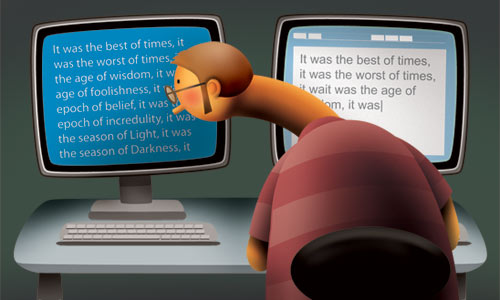What is plagiarism?
Plagiarism is a serious problem in academic writing. Many people think plagiarism only occurs in research articles and consists of taking chunks of information from someone else's work without citing the source.
While this is one type of plagiarism, "borrowing", "copying" or "using" information from a source without proper citations are also plagiarism.
According to the Merriam-Webster Online Dictionary,
- to "plagiarize" means to steal and pass off (the ideas or words of another) as one's own
- to use (another's production) without crediting the source
- to commit literary theft
- to present as new and original an idea or product derived from an existing source
- an act of copying the ideas or words of another person without giving credit to that person
In other words, plagiarism is stealing someone else's work and lying about it afterward.

What is considered plagiarized?
It is not just copy/paste of material that can get you in trouble! According to Plagiarism.org,(Turnitin, 2017) all the following are considered plagiarism
- turning in someone else's work as your own
- copying words or ideas from someone else without giving credit
- failing to put a quotation in quotation marks
- giving incorrect information about the source of a quotation
- changing words but copying the sentence structure of a source without giving credit
- copying so many words or ideas from a source that it makes up the majority of your work, whether you give credit or not (see our section on "fair use" rules)
- Using an image, video or piece of music in a work you have produced without receiving proper permission or providing appropriate citation is plagiarism.
- A whole paragraph with multiple ideas has a single citation at the end of the paragraph instead of connected to the specific information in the paragraph.
Most cases of plagiarism can be avoided, however, by citing sources. Simply acknowledging that certain material has been borrowed and providing your audience with the information necessary to find that source is usually enough to prevent plagiarism. See our section on citation for more information on how to cite sources properly.
Self Plagiarism
Each course assignment must be written for the course in which it is assigned. If you have a question about what written assignments can be used in a course, contact your instructor for guidance.
Re-purposing or reusing papers from previous courses (even the same course taken over) is considered self-plagiarism and is not allowed.
https://www.youtube.com/watch?v=iIuNVzzZ0E8
References:
Plagiarism. (n.d.). In Merriam-Webster's online dictionary. Retrieved from https://www.merriam-webster.com/
Turnitin. (2017). What Is Plagiarism? Retrieved from http://plagiarism.org/article/what-is-plagiarism
Tangney, K. (Producer). (2014, January 18). A message of academic integrity: Intellectual theft [Video file]. Retrieved from https://www.youtube.com/watch?v=iIuNVzzZ0E8


